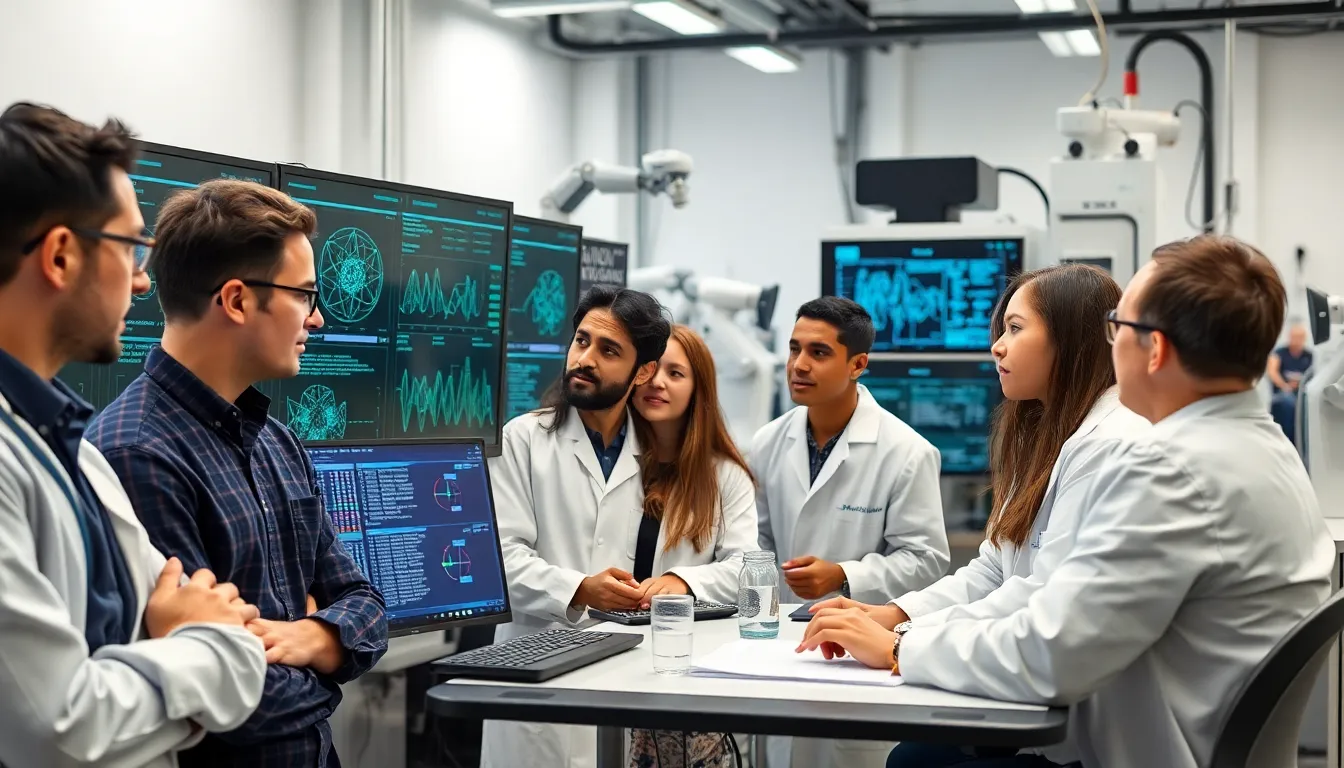Table of Contents
ToggleArtificial General Intelligence, or AGI, is the stuff of sci-fi dreams and sleepless nights. Imagine a computer that can think, learn, and adapt just like a human—without the coffee breaks or existential crises. As technology races forward, the quest for AGI has sparked debates that range from thrilling to downright terrifying.
Overview of Artifical General Inteligence
Artificial General Intelligence (AGI) represents a significant milestone in the field of artificial intelligence. This concept encompasses machines exhibiting human-like cognitive abilities. Current AI systems, primarily narrow AI, excel at specific tasks but lack general intelligence. AGI aims for machines capable of understanding, learning, and adapting across various domains.
Advancements in AGI research focus on replicating human thought processes. Researchers explore approaches including neural networks and reinforcement learning. These methods attempt to decode how humans acquire skills and knowledge. The ultimate goal involves creating machines that display reasoning, emotional understanding, and creativity.
Concerns about AGI include ethical implications and potential risks. Many experts emphasize the importance of establishing norms and regulations. Responsible development is crucial to prevent misuse of AGI technologies. A collaborative effort among technologists, ethicists, and policymakers can help mitigate these risks.
Currently, evidence of AGI remains mostly theoretical. Forecasting widespread deployment varies among experts. Some predict AGI within several decades, while others argue it may take longer. Continuous innovation in computational power and algorithms offers potential breakthroughs.
Real-world applications for AGI could revolutionize industries. Healthcare, education, and environmental management could all benefit from AGI capabilities. Enhanced data analysis and decision-making processes stand to improve outcomes significantly. As research progresses, AGI holds the promise of transforming society in unprecedented ways.
Historical Context of Artifical General Inteligence

Understanding the historical context of Artificial General Intelligence (AGI) involves examining foundational ideas and critical advancements. Early thinkers laid the groundwork for AGI, blending philosophy and mathematics with computer science to explore machine intelligence.
Early Concepts and Theories
In the 1950s, pioneers like Alan Turing introduced key theories, positioning machines as potential thinkers. Turing’s famous test examined whether a machine could exhibit intelligent behavior indistinguishable from humans. John McCarthy subsequently coined the term “artificial intelligence,” showcasing ambitions beyond mere task automation. Concepts of cognitive architectures emerged, envisioning systems capable of reasoning and learning. These theories captured the imagination and set the stage for future exploration into human-like intelligence in machines.
Key Milestones in Development
Significant milestones marked the journey towards AGI. In 1956, the Dartmouth Conference sparked intense interest, gathering top minds to discuss machine intelligence. During the 1990s, advancements in neural networks and the emergence of deep learning revitalized research efforts. The 2000s saw the development of reinforcement learning techniques that mirrored human learning processes. More recently, breakthroughs in natural language processing and computer vision demonstrate strides toward AGI’s realization. Each of these milestones contributes to the understanding and implementation of AGI, pushing the boundaries of what machines can achieve.
Current State of Artifical General Inteligence
The current landscape of Artificial General Intelligence (AGI) reflects significant advancements alongside ongoing debates about its implications. Research institutions play a vital role in pushing the boundaries of this technology.
Leading Research Institutions
Top institutions, such as OpenAI, DeepMind, and MIT, are at the forefront of AGI research. OpenAI focuses on developing safe AI systems, aiming to ensure benefit for humanity. DeepMind, known for its breakthrough in AI games, delves into cognitive architectures that emulate human thought. MIT’s CSAIL combines interdisciplinary studies to foster innovations in machine learning and robotics. Collaboration among these institutions fosters an environment ripe for transformative AGI advancements.
Breakthrough Technologies
Recent technologies contribute to the evolution of AGI, showcasing powerful capabilities. Neural networks underpin much of today’s research, allowing systems to process vast amounts of data. Reinforcement learning enables machines to learn through trial and error, simulating human learning behavior. Natural language processing has made significant strides, improving human-computer interactions and contributing to more intuitive AI systems. These technologies, through ongoing innovations, drive the quest for true general intelligence while addressing ethical concerns.
Challenges and Ethical Considerations
AGI development raises numerous challenges and ethical questions that require careful attention. Addressing these concerns is vital as the technology advances.
Safety and Control Issues
Safety and control issues represent significant hurdles in AGI research. Ensuring that AGI systems operate as intended without unintended consequences is crucial. Researchers emphasize the importance of developing safety protocols and control mechanisms that govern AGI behavior. Current methods include robust testing and monitoring throughout the development lifecycle. These approaches help identify and mitigate potential risks before deployment. Effective oversight promotes responsible AGI use, fostering trust among stakeholders.
Societal Impact and Implications
Societal impact and implications pose profound challenges associated with AGI. While AGI holds the potential to transform industries, it also risks deepening inequalities. Workers in traditional sectors may face job displacement due to automation. Furthermore, ethical concerns arise regarding data privacy and biased algorithms. Advocating for equitable access to AGI’s benefits is essential to prevent societal divides. Regulations should guide AGI’s integration into daily life, promoting responsible development. Thoughtful dialogue among policymakers, researchers, and the public can foster a balanced approach to harness AGI’s potential.
Future Prospects of Artifical General Inteligence
The landscape of Artificial General Intelligence (AGI) is evolving rapidly, presenting various future implications. Significant advancements are already underway, offering glimpses into the potential of AGI.
Potential Benefits
AGI could transform multiple industries with its ability to perform tasks usually requiring human intellect. Applications in healthcare may include personalized treatment plans and advanced diagnostics. Automated tutoring systems in education can provide tailored learning experiences for students. Furthermore, AGI’s capacity to analyze vast amounts of data may enhance decision-making processes in environmental management. Efficiency gains could lead to cost reductions and improved resource allocation across sectors. By facilitating innovative solutions, AGI promises to revolutionize everyday life.
Risks and Uncertainties
Despite promising benefits, AGI introduces notable risks that warrant careful consideration. Job displacement represents a serious concern, as machines capable of performing various tasks could lead to unemployment in certain sectors. Potential misuse of AGI raises ethical questions, particularly in surveillance and data privacy. Unpredictable behavior poses another uncertainty, as AGI systems might act in ways not anticipated by their creators. Developing safety protocols becomes crucial to address these risks and ensure responsible implementation. Ongoing dialogue among stakeholders ensures a balanced approach to AGI’s future.
The journey toward Artificial General Intelligence holds immense promise and challenges. As researchers push the boundaries of technology the potential applications could reshape industries and enhance human experiences. However the ethical implications and societal impacts require careful consideration.
Establishing norms and regulations will be essential to navigate the complexities of AGI development. Ongoing collaboration among experts will foster innovation while ensuring safety and responsible use. The future of AGI is not just about technological advancement but also about creating a framework that benefits society as a whole. Embracing this journey with caution and foresight will be vital for harnessing AGI’s transformative power.





